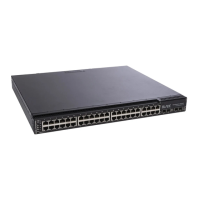© Copyright IBM Corp. 2011 183
Chapter 15. Basic IP Routing
This chapter provides configuration background and examples for using the G8000
to perform IP routing functions. The following topics are addressed in this chapter:
•
“IP Routing Benefits” on page 183
•
“Routing Between IP Subnets” on page 183
•
“Example of Subnet Routing” on page 184
•
“ECMP Static Routes” on page 187
•
“Dynamic Host Configuration Protocol” on page 189
IP Routing Benefits
The switch uses a combination of configurable IP switch interfaces and IP routing
options. The switch IP routing capabilities provide the following benefits:
•
Connects the server IP subnets to the rest of the backbone network.
•
Provides the ability to route IP traffic between multiple Virtual Local Area
Networks (VLANs) configured on the switch.
Routing Between IP Subnets
The physical layout of most corporate networks has evolved over time. Classic
hub/router topologies have given way to faster switched topologies, particularly now
that switches are increasingly intelligent. The G8000 is intelligent and fast enough to
perform routing functions at wire speed.
The combination of faster routing and switching in a single device allows you to
build versatile topologies that account for legacy configurations.
For example, consider a corporate campus that has migrated from a router-centric
topology to a faster, more powerful, switch-based topology. As is often the case, the
legacy of network growth and redesign has left the system with a mix of illogically
distributed subnets.
This is a situation that switching alone cannot cure. Instead, the router is flooded
with cross-subnet communication. This compromises efficiency in two ways:
•
Routers can be slower than switches. The cross-subnet side trip from the switch
to the router and back again adds two hops for the data, slowing throughput
considerably.
•
Traffic to the router increases, increasing congestion.
Even if every end-station could be moved to better logical subnets (a daunting task),
competition for access to common server pools on different subnets still burdens the
routers.
This problem is solved by using switches with built-in IP routing capabilities.
Cross-subnet LAN traffic can now be routed within the switches with wire speed
switching performance. This eases the load on the router and saves the network
administrators from reconfiguring every end-station with new IP addresses.

